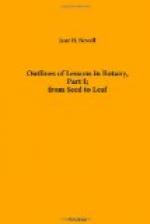One’s aim in these lessons should always be to tell the pupils as little as possible. Try to lead them to think out these things for themselves.
Ask them how plants differ from animals. They will say that plants are fixed to one place, while animals can move about; that plants have no will or consciousness, and that animals have. These answers are true when we compare the higher animals with plants, but the differences become lost as we descend in the scale and approach the border land where botanist and zoologist meet on a common ground. Sea-anemones are fixed to the rock on which they grow, while some of the lower plants are able to move from place to place, and it is hardly safe to affirm that a jelly-fish is more conscious of its actions than is a Sensitive Plant, the leaves of which close when the stem is touched.
There is no real division between animals and plants. We try to classify the objects about us into groups, according to the closeness of their relationships, but we must always remember that these hard lines are ours, not Nature’s. We attempt, for purposes of our own convenience, to divide a whole, which is so bound together that it cannot be separated into parts that we can confidently place on different sides of a dividing line.
1. Plants as Food-Producers.—The chief distinguishing characteristic of plants is one that the pupils may be led to think out for themselves by asking them what animals feed upon. To help them with this, ask them what they had for breakfast. Oatmeal is mentioned, perhaps. This is made from oats, which is a plant. Coffee and tea, bread made from wheat, potatoes, etc., all come from plants.[1] Beef, butter and milk come from the cow, but the cow lives upon grass. The plant, on the other hand, is nourished upon mineral or inorganic matter. It can make its own food from the soil and the air, while animals can only live upon that which is made for them by plants. These are thus the link between the mineral and animal kingdoms. Ask the scholars if they can think of anything to eat or drink that does not come from a plant. With a little help they will think of salt and water. These could not support life. So we see that animals receive all their food through the vegetable kingdom. One great use of plants is that they are food-producers.
[Footnote 1: Reader in Botany, for use in Schools. Selected and adapted from well-known authors. Ginn & Co., Boston, New York and Chicago, 1889. I. Origin of Cultivated Plants.]
This lesson may be followed by a talk on food and the various plants used for food.[2]
[Footnote 2: The Flour Mills of Minneapolis: Century Magazine, May, 1886. Maize: Popular Science News, Nov. and Dec., 1888.]
2. Clothing.—Plants are used for clothing. Of the four great clothing materials, cotton, linen, silk, and woollen, the first two are of vegetable, the last two of animal origin. Cotton is made from the hairs of the seed of the cotton plant.[1] Linen is made of the inner fibre of the bark of the flax plant. It has been cultivated from the earliest historical times.




